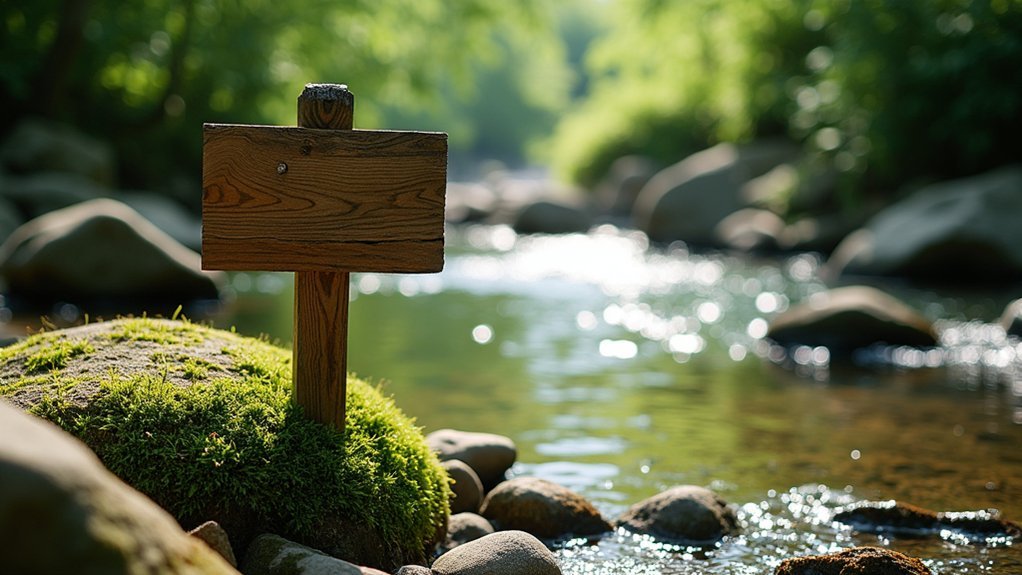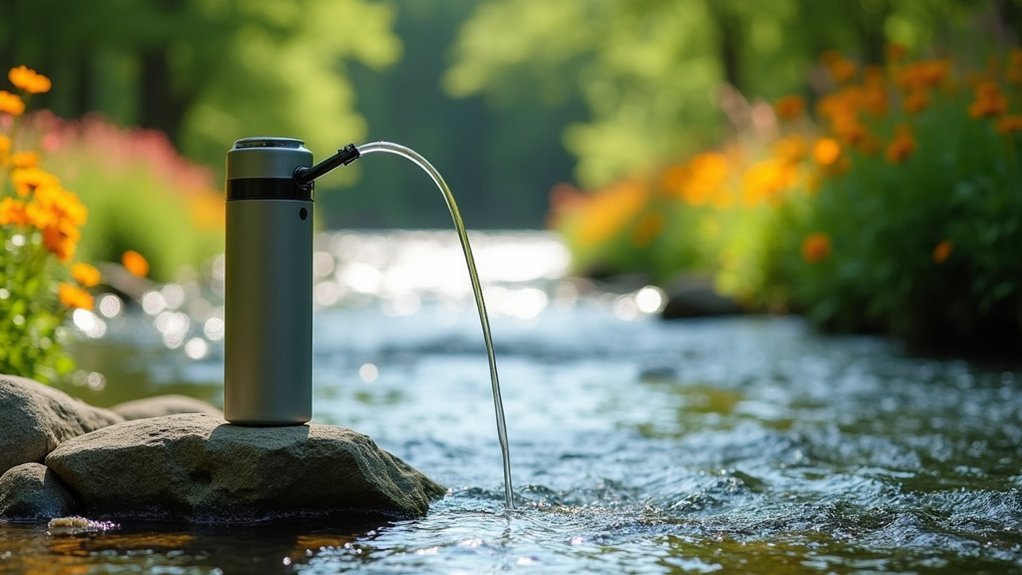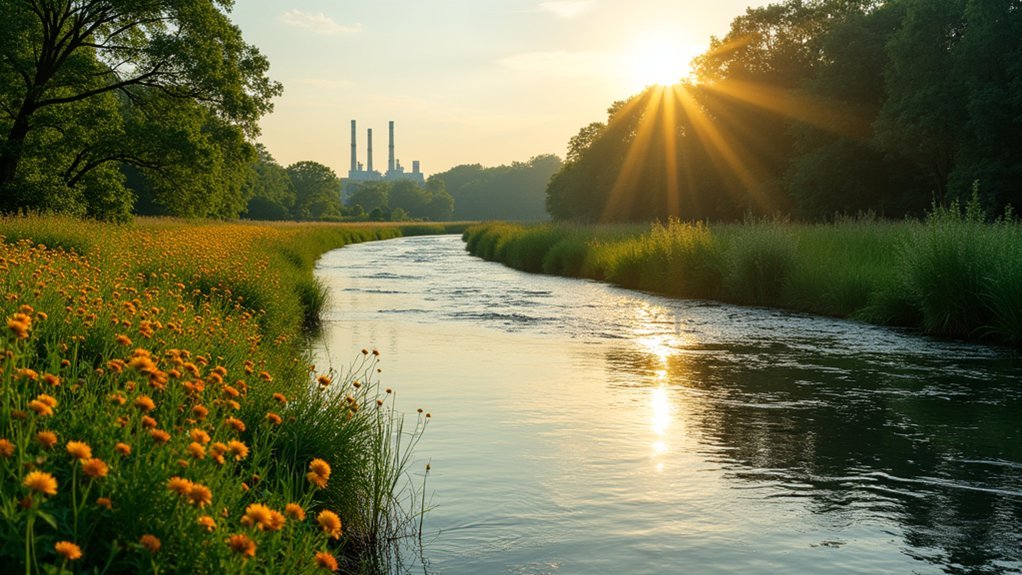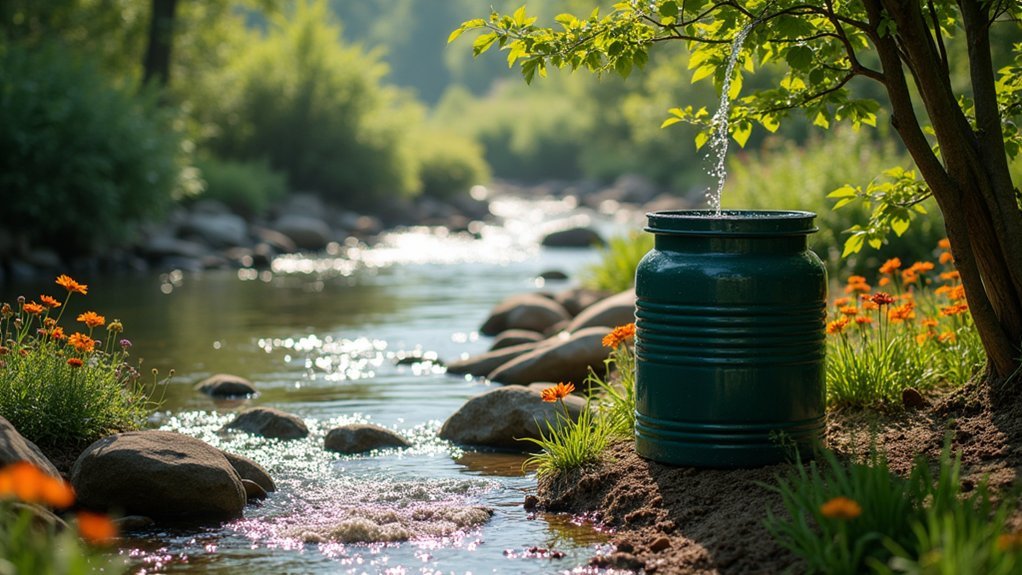Never drink creek water without treatment, even if it looks clean. Always choose clear, flowing sources over stagnant pools and inspect upstream for pollution. Boil water for at least 5 minutes (longer at high elevations), use portable filters as backup, and consider rainwater collection as a safer alternative. Stay informed about local water quality reports and avoid creeks near industrial zones or heavy wildlife activity. These fundamental precautions could save you from serious waterborne illnesses.
10 Best Safety Tips For Creek Drinking Water

While creek water might look pristine and rejuvenating, you should always assume it's contaminated with harmful pathogens. Bacteria like E. coli and parasites such as giardia can cause severe illness if you consume untreated creek water.
Before collecting drinking water, scan upstream for pollution sources like agricultural runoff or industrial activities. Always choose rapidly flowing sections where water tumbles over rocks and sand, as these areas typically contain fewer contaminants.
Never drink creek water without treatment. Boil it vigorously for at least one minute to kill harmful microorganisms, or use a reliable water filter designed for backcountry use.
If you have a well that's fed by creek water, test it regularly as underground contamination can occur.
These precautions will greatly reduce health risks when creek water is your only option.
Always Look for Clear Flowing Water Sources
When searching for drinkable creek water, your first priority should be identifying clear, flowing sources. Moving water is typically safer than stagnant pools because it's less likely to harbor harmful bacteria and contaminants. Look for streams that flow over rocks and sand, as these natural features help filter impurities.
| Water Characteristic | Safety Level | Why It Matters |
|---|---|---|
| Fast-moving rapids | High | Constantly oxygenated, fewer pathogens |
| Clear water over rocks | Medium-High | Natural filtration occurs |
| Slow-moving but clear | Medium | Better than stagnant, but verify upstream |
Always check upstream conditions—avoid drinking from creeks near farms or urban areas where runoff may introduce chemicals. You'll want water sources with no visible pollution, unusual colors, or strange odors. Remember, safe water shouldn't have any industrial or livestock activities within two miles upstream.
Assess Upstream Activities Before Collecting

Before you collect any creek water, thoroughly investigating the upstream landscape is essential for your safety.
Always evaluate the surrounding area within a two-mile radius upstream, looking for potential contamination sources that could make water treatment more difficult or impossible.
Watch for these critical warning signs:
- Agricultural activities with potential pesticide or fertilizer runoff
- Industrial facilities that might discharge waste into waterways
- Livestock grazing areas that introduce animal waste contaminants
- Signs of human recreation or camping sites
Even crystal-clear water can harbor invisible pathogens from upstream activities.
Don't be fooled by appearances—wildlife presence, especially waterfowl, indicates potential pathogen risks.
Remember that visual inspection alone isn't enough; effective water treatment depends on understanding what's happening upstream from your collection point.
Boil Creek Water for At Least 5 Minutes
Boiling is your most reliable defense against waterborne pathogens hiding in creek water. You'll need to boil creek water for at least 5 minutes to effectively kill harmful bacteria, viruses, and protozoa that could make you sick.
The CDC recommends a rolling boil for one minute at elevations below 6,562 feet, but extend this to three minutes at higher altitudes where water boils at lower temperatures.
Don't settle for simmering—ensure a vigorous, rolling boil to guarantee pathogen destruction.
This method also helps reduce certain chemical contaminants that other purification methods might miss.
When you're in an emergency situation without access to filters or purification tablets, boiling remains your most accessible and dependable option for creating safe drinking water.
Use Portable Water Filters Designed for Backcountry

Portable water filters offer a convenient alternative to boiling when you're exploring creek environments.
These lightweight devices remove 99.9% of harmful bacteria and protozoa while maintaining excellent water safety standards. When selecting a backcountry filter, consider both flow rate and treatment capacity to match your wilderness needs.
For ideal filtration results:
- Choose filters with hollow fiber membrane technology for effective pathogen removal
- Look for models with activated carbon to improve taste and reduce chemicals
- Verify your filter can handle your water volume (some treat up to 10,000 liters)
- Maintain your filter regularly to prevent clogging, especially after filtering muddy water
Most quality filters are compact enough for your pack while providing quick access to safe drinking water – some can filter several liters per minute without electricity or chemicals.
Test for Chemical Contaminants in Urban Areas
Urban creeks require chemical testing before you consider drinking their water, as they're often contaminated with heavy metals and VOCs from street runoff and industrial discharge.
You'll need to check for historical pollution data and consider using testing kits provided by local environmental agencies to identify potential hazards.
For reliable results, send water samples to a certified laboratory that can accurately measure chemical contaminant levels against established safety standards.
Chemical Testing Essentials
When creek water flows through urban landscapes, it often collects invisible chemical contaminants that pose serious health risks. To guarantee safety, you'll need chemical testing essentials that detect heavy metals, pesticides, and industrial byproducts that can persist even when water appears clean.
Prioritize these testing steps:
- Purchase certified water testing kits that detect lead, nitrates, and VOCs.
- Follow local environmental agency guidelines for proper testing frequency.
- Test more frequently after rainfall when contaminants surge from runoff.
- Document results over time to identify patterns in contamination levels.
Understanding your creek's specific chemical profile helps you recognize potential hazards before using the water.
Don't rely on visual inspection alone—regular chemical testing is your best defense against hidden urban pollutants.
Urban Runoff Dangers
Hidden beneath the surface of seemingly pristine creek water, chemical contaminants from urban runoff pose serious health risks you can't detect with your eyes alone.
After rain events, creeks near urban areas become particularly hazardous as stormwater washes heavy metals, pesticides, and oils from streets and parking lots directly into waterways.
Don't be fooled by clear-looking untreated water in urban creeks. These waterways frequently contain lead, copper, and PAHs at levels exceeding safety thresholds.
Visual inspection can't reveal these invisible threats.
Before collecting water from any urban creek, consider the surrounding environment and recent rainfall.
If possible, seek water sources upstream from urban areas. Communities implementing green infrastructure like bioswales and rain gardens typically have reduced chemical contamination in nearby waterways.
Avoid Creeks Near Industrial Zones or Runoff

Although creek water might appear pristine and natural, sources located near industrial zones pose significant health hazards that you can't detect with the naked eye.
Creek water near industrial areas harbors invisible toxins despite its natural appearance.
Always avoid creeks near industrial zones, as these waterways often contain dangerous pollutants released during manufacturing processes.
For your safety, maintain these critical distances and precautions:
- Stay at least 2 miles away from any industrial facilities when selecting creek water.
- Examine surrounding landscapes for signs of urban runoff channels.
- Check for agricultural activity upstream that might introduce pathogens.
- Never trust water clarity as an indicator of safety – invisible contaminants like heavy metals and chemicals remain undetectable visually.
Remember that contaminated groundwater can travel significant distances from its source, carrying industrial pollutants to seemingly isolated creeks.
Learn Natural Filtration Techniques for Emergencies
When faced with a wilderness emergency, you'll find sand and rock filtration systems remarkably effective at removing visible contaminants from creek water.
You can enhance purification by creating a simple charcoal filter using burned wood remnants layered with sand and gravel in a container with drainage holes.
Certain plants like cattail roots, pine needles, and moss can also help purify water when properly arranged in layered filtration systems, though always remember to boil or chemically treat the filtered water before drinking.
Sand and Rock Systems
Natural filtration through sand and rock systems can be an essential skill in emergency situations when clean drinking water is unavailable. By digging a hole near a creek's edge, you'll create a simple but effective filtration system as water seeps through surrounding soil and gravel, reducing some contaminants before collection.
When implementing sand and rock systems, remember these key points:
- Dig your seep hole in sandy areas at least 3 feet from the creek's edge.
- Wait for the hole to fill with clearer water that's been naturally filtered.
- Check for potential contamination sources upstream before relying on this method.
- Always boil or further purify the filtered water when possible.
While these natural filters improve water quality, they don't eliminate all pathogens, so consider them only one step in your water safety protocol.
Emergency Charcoal Filtration
Three key ingredients make charcoal filtration a vital emergency water purification method when you're near a creek with questionable water quality. First, activated charcoal's powerful adsorption properties trap contaminants. Second, the layered filtration system removes particulates. Third, it's relatively easy to create in wilderness situations.
To implement emergency charcoal filtration effectively:
| Material | Purpose | Placement |
|---|---|---|
| Cloth/Coffee Filter | Blocks large debris | Top layer |
| Untreated Wood Ash | Creates activated charcoal | Middle layer |
| Sand | Captures fine sediments | Below charcoal |
| Small Gravel | Supports filtration layers | Bottom layer |
| Container | Collects filtered water | Base system |
Always boil your water after filtration to kill remaining pathogens. Practice building this system before venturing into the wilderness—your preparation could be lifesaving when clean drinking water becomes scarce.
Plant-Based Water Purification
While emergency charcoal filtration offers a reliable solution for water purification, nature provides additional resources through plant-based methods that have sustained humans for centuries.
You can create your own plant-based water purification system using readily available natural materials.
Construct a simple but effective filtration system by:
- Layering materials with gravel at the bottom, activated charcoal in the middle, and fine sand at the top
- Incorporating water-purifying plants like hyacinth or cattails around your water source
- Creating activated charcoal by burning specific plant materials for enhanced filtration
- Combining your plant-based filter with boiling or chemical treatment for complete safety
Watch for Wildlife Warning Signs at Collection Points
Before collecting water from any creek, you'll need to carefully inspect the area for signs of wildlife activity that could contaminate your drinking supply. Animals like ducks and geese can introduce harmful pathogens into the water, making it unsafe to drink without proper treatment.
| Wildlife Sign | What It Indicates |
|---|---|
| Footprints | Recent animal presence |
| Droppings | Direct contamination risk |
| Nests | Regular wildlife activity |
| Dead animals | Severe contamination hazard |
| Livestock trails | Potential upstream waste |
Avoid shallow pools or areas where animals frequently gather. If you notice signs of decaying organic matter near your collection point, move upstream to find cleaner water. Remember that livestock contamination can be especially problematic, so always check for farm activity before selecting your water source.
Collect Rainwater as a Safer Alternative

Install food-grade containers with clean, properly angled gutters to collect rainwater efficiently from your roof without debris contamination.
You'll need a sealed storage system with first-flush diverters to prevent initial runoff containing bird droppings and environmental pollutants from entering your main supply.
Regular cleaning of collection surfaces and storage tanks will prevent algae growth and bacterial buildup, ensuring your rainwater remains a safer alternative to potentially pathogen-laden creek water.
Proper Collection Techniques
Instead of relying on potentially contaminated creek water, you'll find that rainwater collection offers a considerably safer drinking alternative during outdoor adventures.
When collecting rainwater, always prioritize cleanliness throughout the process.
For ideal safety when harvesting rainwater:
- Use only food-grade containers that haven't been exposed to harmful chemicals or contaminants.
- Set up your collection system away from overhanging trees, bird perches, or other sources of contamination.
- Cover collection containers with fine mesh screens to prevent debris and insects from entering.
- Clean your collection surface before the rain begins to wash away any accumulated dirt or droppings.
Remember to purify your collected rainwater through boiling or filtration before drinking, as this provides an extra layer of protection against potential pathogens.
Storage System Requirements
Three essential components make up a proper rainwater storage system for drinking purposes.
First, verify you have a clean collection surface, typically a roof that's regularly maintained.
Second, install a first-flush diverter that redirects initial dirty runoff away from your storage tank, preventing contaminants from entering your water supply.
Finally, use an opaque storage tank that blocks sunlight to prevent algae growth. This tank should be covered and regularly cleaned to maintain water quality.
Even with these precautions, treating water before consumption is vital. Consider boiling or filtering your harvested rainwater to eliminate any remaining pathogens.
Regular maintenance of your entire system will greatly reduce contamination risks and provide you with a safer alternative to creek water, which often contains harmful microorganisms.
Maintenance Prevents Contamination
While creek water often harbors harmful microorganisms from wildlife and upstream contamination, properly maintained rainwater collection systems provide a markedly safer drinking alternative.
Unlike creek water, which typically requires treatment plant-level processing to be safe, your rainwater system needs only regular maintenance and basic treatment methods.
To keep your rainwater collection system contaminant-free:
- Clean catchment surfaces quarterly, removing debris, bird droppings, and accumulated dust
- Replace or clean filters monthly to guarantee efficient pathogen and particulate removal
- Inspect storage containers for cracks or leaks that could allow external contamination
- Test collected water every six months for bacterial growth and chemical pollutants
Store your harvested rainwater in opaque containers to prevent algae growth, and remember that even rainwater requires treatment through boiling, filtering, or chemical disinfection before drinking.
Frequently Asked Questions
How Do You Make Creek Water Safe to Drink?
You can make creek water safe to drink by boiling it for one minute, using a portable water filter, or adding chemical disinfectants like iodine tablets. Always test for contaminants when possible.
Is Water From a Creek Safe to Drink?
No, creek water isn't safe to drink untreated. You're risking exposure to harmful pathogens like giardia and E. coli. You'll need to boil, filter, or chemically treat it first to remove dangerous contaminants.
How Do You Drink Stream Water Safely?
You should always purify stream water before drinking it. Boil it for at least one minute, use specialized water filters, or apply chemical treatments like iodine tablets. Never drink untreated water, even if it looks clear.
How Do You Sanitize Creek Water?
You can sanitize creek water by boiling it for one minute, using EPA-approved filters, adding chemical disinfectants like iodine tablets, trying solar disinfection, or filtering through sand and charcoal in emergencies.
In Summary
When you're thirsty in the wilderness, your safety depends on smart water choices. By following these ten practical tips, you'll reduce your risk of waterborne illness while staying hydrated outdoors. Remember, no water source is 100% guaranteed safe, so always use multiple purification methods when possible. With proper preparation and knowledge, you can confidently enjoy nature's water sources during your adventures.




Leave a Reply